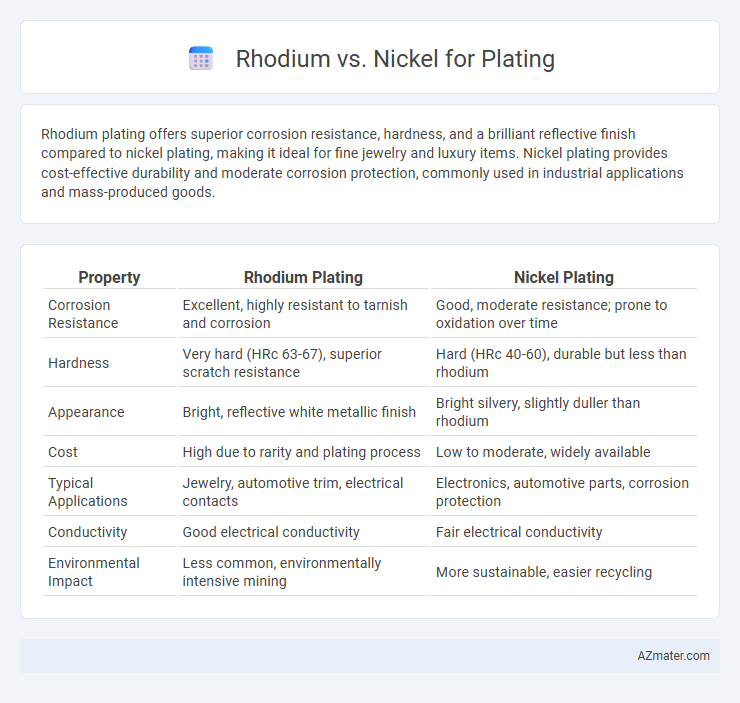Rhodium plating offers superior corrosion resistance, hardness, and a brilliant reflective finish compared to nickel plating, making it ideal for fine jewelry and luxury items. Nickel plating provides cost-effective durability and moderate corrosion protection, commonly used in industrial applications and mass-produced goods.
Table of Comparison
| Property | Rhodium Plating | Nickel Plating |
|---|---|---|
| Corrosion Resistance | Excellent, highly resistant to tarnish and corrosion | Good, moderate resistance; prone to oxidation over time |
| Hardness | Very hard (HRc 63-67), superior scratch resistance | Hard (HRc 40-60), durable but less than rhodium |
| Appearance | Bright, reflective white metallic finish | Bright silvery, slightly duller than rhodium |
| Cost | High due to rarity and plating process | Low to moderate, widely available |
| Typical Applications | Jewelry, automotive trim, electrical contacts | Electronics, automotive parts, corrosion protection |
| Conductivity | Good electrical conductivity | Fair electrical conductivity |
| Environmental Impact | Less common, environmentally intensive mining | More sustainable, easier recycling |
Introduction to Rhodium and Nickel Plating
Rhodium plating offers exceptional corrosion resistance, bright reflective finish, and hardness, making it ideal for jewelry and automotive parts. Nickel plating provides excellent adhesion, wear resistance, and cost-effectiveness, commonly used in electrical components and decorative applications. Selecting between rhodium and nickel plating depends on performance requirements, budget, and aesthetic preferences.
Key Properties of Rhodium Plating
Rhodium plating offers exceptional hardness and corrosion resistance, making it a top choice for jewelry and automotive parts requiring durable, scratch-resistant finishes. Its brilliant white reflectance provides a high luster and maintains a tarnish-free appearance over time, unlike nickel plating which can oxidize and dull. The hypoallergenic nature of rhodium plating minimizes skin irritation, enhancing its suitability for fine jewelry applications.
Key Properties of Nickel Plating
Nickel plating offers excellent corrosion resistance and high hardness, making it ideal for protective coatings on automotive, aerospace, and electronic components. Its uniform deposit and good ductility provide enhanced durability and wear resistance in industrial applications. Nickel plating also exhibits strong adhesion to various substrates and good solderability, ensuring reliable performance in both decorative and functional uses.
Visual Differences: Rhodium vs. Nickel Finish
Rhodium plating offers a bright, reflective white finish with superior corrosion resistance and a mirror-like shine that enhances jewelry brilliance. Nickel plating tends to have a slightly warmer, duller appearance that may develop a patina or tarnish over time, reducing its visual appeal. Rhodium's crisp, modern look contrasts with nickel's more traditional, muted tone, making rhodium the preferred choice for high-end, visually striking surfaces.
Durability and Wear Resistance Comparison
Rhodium plating offers superior durability and wear resistance compared to nickel, making it ideal for high-wear applications such as jewelry and electronics. Rhodium's hardness rating of 6 on the Mohs scale significantly outperforms nickel, which ranks around 4, resulting in enhanced scratch resistance and longevity. Nickel plating provides good corrosion protection but tends to wear faster under abrasive conditions, whereas rhodium maintains its reflective finish and structural integrity over extended use.
Corrosion and Tarnish Protection
Rhodium plating offers superior corrosion resistance compared to nickel, forming a dense, inert layer that protects underlying metals from oxidation and tarnish. Nickel plating, while providing a durable barrier against corrosion, is more prone to discoloration and tarnish over time, especially in humid or acidic environments. For applications demanding long-lasting shine and robust corrosion protection, rhodium plating remains the preferred choice.
Hypoallergenic Considerations
Rhodium plating offers excellent hypoallergenic properties, making it a preferred choice for individuals with sensitive skin or metal allergies, as it is less likely to cause irritation compared to nickel. Nickel, widely used in plating, is a common allergen responsible for contact dermatitis and skin reactions in many people. Choosing rhodium plating for jewelry or wearable items significantly reduces the risk of allergic responses, ensuring safer and more comfortable wear.
Cost Analysis: Rhodium vs. Nickel Plating
Rhodium plating typically incurs higher costs than nickel plating due to rhodium's rarity and expensive extraction process, often making it two to three times more expensive per square inch. Nickel plating provides a more budget-friendly option while offering good corrosion resistance and durability, ideal for large-scale industrial applications. When balancing cost with aesthetic and protective qualities, nickel plating is preferred for cost efficiency, whereas rhodium plating justifies its premium price in luxury jewelry and high-end electronics for its superior brightness and tarnish resistance.
Common Applications in Jewelry and Industry
Rhodium plating is prized in the jewelry industry for its bright white finish, corrosion resistance, and ability to enhance the appearance of white gold and silver pieces. Nickel plating offers robust wear resistance and cost efficiency, making it a popular choice for industrial applications such as electronics, automotive parts, and machinery components. While rhodium provides superior tarnish protection and hypoallergenic properties for fine jewelry, nickel's durability and lower expense suit it for heavy-duty industrial use.
Choosing the Right Plating Option
Rhodium plating offers superior corrosion resistance, a brilliant white finish, and excellent durability, making it ideal for high-end jewelry and electronics. Nickel plating provides a cost-effective solution with good hardness and wear resistance but is more prone to allergenic reactions and tarnishing over time. Selecting the right plating depends on factors such as budget, desired aesthetic, wear conditions, and potential skin sensitivity.

Infographic: Rhodium vs Nickel for Plating
 azmater.com
azmater.com